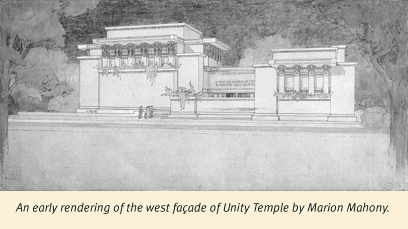The first idea was to keep a noble room for worship in mind.
—Frank Lloyd Wright FRANK LLOYD WRIGHT'S UNITY TEMPLE, the home of the Unitarian Universalist Congregation in Oak Park, Illinois, is one of the best-known and frequently illustrated buildings of the twentieth century and would, probably by consensus, be deemed a major monument in the history of American and even world architecture. The building is visited by tens of thousands each year; its great acoustics make it a much-desired venue for professional musicians; the beauty of its interior makes it much sought after for social, religious, and charitable events by people of a wide variety of backgrounds. The building is not large, though the combination of its massing and the concrete construction give it a dignity and presence that makes it seem larger than it really is. But, once one is inside, the experience of light, color, and the exquisiteness of the geometry place the visitor in another world, and that is the source of Wright's genius. 
Justly famous for its innovations both in design and technique, and widely appreciated on a purely aesthetic basis, it was characterized by Wright as his best early building and has been mentioned and praised by hundreds of writers. Clearly, Wright thought of this building as one of the most important of his career, and the summation of the ideas to which he was attracted in his early years, saying, "Unity Temple makes an entirely new architecture," and, "When I finished Unity Temple, I had it. I knew I had the beginning of a great thing, a great truth in architecture. Now architecture could be free." Yet, for all its worldwide fame, it has been discussed in detail by few. Even during Wright's lifetime, and certainly from Grant C. Manson's pioneering critical study Frank Lloyd Wright to 1910: The First Golden Age published the year before the architect died in 1959, through the popular biography Many Masks: A Life of Frank Lloyd Wright, by Brendan Gill, published in 1987, both scholars and popularizers alike have relied all too heavily on Wright's An Autobiography. They have accepted the author's description in the chapter, "Designing Unity Temple," as both literal and factual, ignoring both Wright's obvious disinterest in historical narrative and his disinclination to share the limelight with others who may have had a significant role in any of his |

Top Five Books, LLC,
is a Chicago-based independent publisher dedicated to publishing only the finest fiction, timeless classics, and select nonfiction.
is a Chicago-based independent publisher dedicated to publishing only the finest fiction, timeless classics, and select nonfiction.
© Top Five Books, LLC.
All rights reserved.